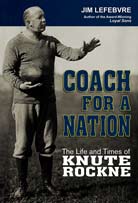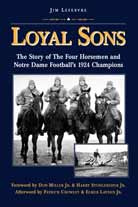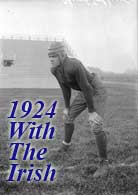When Notre Dame kicks off against Miami in the December 31 Sun Bowl, it will have completed the circuit of having played in all the truly “historic” bowl games – Rose, Orange, Sugar, Cotton and Sun, all of which began in the 1930s or earlier (Rose, 1902).
But it won’t be the first time a Fighting Irish bowl team traveled to “the West Texas town of El Paso.”
That’s because the very first Notre Dame bowl team – Knute Rockne’s 1924 national champions featuring The Four Horsemen and The Seven Mules – had El Paso on its itinerary as it made its unique journey to and from the Jan. 1, 1925 Rose Bowl.
The backdrop to the historic 1924 season was an event from the spring of that year. The Ku Klux Klan, a rising power flexing its anti-Catholic muscles, planned a major rally for downtown South Bend, and hundreds of ND students, including several football players, took the bait and went up against the Klan in what became something of a melee.
The Klan used the altercation to further enflame anti-Catholic passion, painting the ND lads as ruffians out to upset a group of Klansmen who had peaceably assembled.
Anyone who knew the facts realized this was nonsense, but the fact remained – ND had something of a PR problem on its hands. Rev. John O’Hara, prefect of religion at the time (akin to a dean of students) felt strongly that the nation must be shown a better image of Notre Dame. And Rockne presented him with the perfect platform – a powerful football team of clean-cut fellows who mowed down the strongest teams from across the land, in defeating Army, Princeton, Georgia Tech, Wisconsin, Nebraska.
 |
| The ND Rose Bowl party prepares to depart Chicago’s Illinois Central station. |
As the word of Rockne’s “wonder team” led by the “four horsemen” took root among the nation’s sporting fans, O’Hara, with Rock’s blessings, hatched the idea of a cross-country trip to showcase and celebrate these outstanding young men, the best face of Notre Dame.
So when the invitation to meet Pop Warner’s Stanford team in the Rose Bowl materialized, so did O’Hara’s plan for a three-week odyssey to and from Pasadena. The trip would allow ND alums, local Knights of Columbus clubs, local clergy and the average fan to pay honor to the undefeated Irish. Stops were planned in Memphis, New Orleans, Houston, El Paso and Tucson, before arriving in southern California.
The fetes started in South Bend, where first a packed downtown banquet, then a rousing sendoff at the old Gymnasium, ignited unprecedented passion for the team.
At 10:17 on Saturday morning, December 20, from a campus nearly deserted by students headed home for the holidays, the Fighting Irish started their journey, heading first to Chicago. Almost on cue, a winter storm featuring snow, cold and fierce winds slammed into South Bend. Rockne’s support of the long trip looked wise. At 8:15 Saturday evening the team, cheered by several hundred Notre Dame fans who had gathered, left Chicago on the Illinois Central bound for New Orleans. The first stop, at 8:50 Sunday morning, was Memphis, where a group of Notre Dame alums and Knights of Columbus met the Notre Dame party and escorted them to St. Peter’s Church for Mass.
Sunday afternoon in New Orleans, the temperature dipped below freezing and for a few moments, snow flurries fell for the first time in a decade. Despite the chill, more than 600 people gathered outside the Union Station long before the approach of the Notre Dame football train, anxious to get a look at the famous team. Among the crowd were Notre Dame alumni as well as students from Holy Cross College, which like Notre Dame was operated by the Congregation of the Holy Cross. The school was founded in 1849 – just seven years after Notre Dame – when five Holy Cross priests and brothers traveled to New Orleans from South Bend. In 1879, when Notre Dame’s Main Building burned to the ground and seriously threatened the continued existence of the school, the Holy Cross school of New Orleans sold a piece of its property for $10,000 and sent the money north to help Notre Dame rebuild.
As the train pulled in on the station’s outer track, cheers went up for the famous team and its coach:
“Rah rah rah rah”
“N-O-T-R-E D-A-M-E”
“Rock-ne Rock-ne Rock-ne”
“Yea Yea Yea”
Regular passengers at the station found it hard to maneuver through the huge crowd. As the Irish players stepped off the train, they were guided through the baggage room to waiting cars. Everyone wanted a glimpse.
“Say, isn’t that Harry Stuhldreher, one of the Four Horsemen?”
“Isn’t he simply grand,” one girl remarked of Adam Walsh.
“There goes Don Miller.”
“These boys are too good looking to be football players.”
The players appeared small, a local reporter commented. Not like a team that has gone through a season undefeated against some of the nation’s best elevens.
From the station, the squad was ferried by auto to the Roosevelt Hotel, where they were mobbed by well-wishers in the lobby. A “carnival crowd” pushed as they tried to get near the players; Stuhldreher had a large group offering congratulations. In the banquet hall, the players devoured a turkey dinner amid some short welcoming speeches. Monday morning, they arose for 8:30 Mass at Sacred Heart Church. After a breakfast at the Roosevelt, the team was taken on a boat ride through the New Orleans harbor aboard the Marie, the yacht of B.S. D’Antoni, president of the Loyola Athletic Council. After that, it was a luncheon at Holy Cross hosted by President Brother Matthew. By mid-afternoon, the Irish were on the field at Loyola University’s stadium, where some 500 fans gathered to watch the team go through its paces. Though it wasn’t a full scrimmage, fans were able to see the first unit mostly on defense, practicing against the anticipated Stanford plays. After practice, it was back to the Roosevelt for a performance by a group of Loyola students, then a huge banquet put on by Notre Dame and Holy Cross alumni.
After Mass and breakfast Tuesday morning, the team returned to Loyola for another brief workout, consisting of passing and kicking, a signal practice and dummy scrimmage. Before departing for Houston on the Sunset Limited just after noon, Rockne thanked New Orleans for its gracious reception, but added that once in Houston, the social calendar would be cleared out and the players would get down to work in preparation for the big game. He also changed the team’s itinerary, skipping the stopover at El Paso in order to get more quickly to Tucson, where he felt the team could establish a base of operation more conducive to working up to game readiness.
Unusual weather continued to precede the team’s travels, as Houston was under a mantle of ice from a storm that dropped temperatures to 22 degrees, the city’s lowest reading in years. Local trains and telegraph services were out, leaving Houston “cut off from the rest of the world,” according to one report. The idea of acclimating the team to warm southern weather was not working out. But the traveling party pressed on, rolling over Southern Pacific lines on the Sunset Limited and pulling into Houston late Tuesday night. They were greeted by the local Knights of Columbus and taken to the Bender Hotel. A noon banquet on Wednesday, December 24, honored the team, after which a practice at the Rice Institute field elicited more pessimism from Rockne. The team looked soft and slow, he told reporters, due to too many rich meals at banquets and not enough physical exertion.
On Christmas Eve, Father O’Hara tried to lighten the mood by playing Santa Claus for the fellows, giving them each a token of the school’s admiration of them. The team attended midnight Mass at Sacred Heart Church. For most of the players, it was the first Christmas away from home. “It will be hard times not to spend Christmas at home,” wrote Elmer Layden to loved ones. Wrote fellow Horseman Don Miller: “While I am sorry that I cannot be home during the Holidays, I am thankful for the chance to see the Pacific.”
When Knute Rockne stepped off the train in Tucson, he looked up at a bright blue sky and broke into a wide grin, rubbing his hands together in anticipation. Finally they had encountered the mild weather he had hoped for. Minutes later, after a member of the welcoming committee gave him the schedule of receptions, dinners and banquets, his mood darkened. Rockne thought that his club was already showing the physical and psychological effects of too many feasts on the trip and that the players needed a different regimen. His hosts explained that special care was being taken to feed his players healthy food and allow them plenty of rest, and he again smiled and gave his approval.
The stop in Tucson was originally scheduled for two days, December 29 and 30, but with El Paso off the itinerary, the team would spend four days in the Arizona city. No place on the tour was more excited to be hosting the Irish. In early December, representatives of Tucson and the University of Arizona lobbied Notre Dame officials to consider taking the Southern Pacific route west and to spend some time in their area. The university offered thorough accommodations, including use of all its athletic facilities, especially its well-maintained football field.
The chef at the Santa Rita hotel, Notre Dame’s headquarters, was given instructions on what to prepare for the players. Each player’s diet was to be strictly monitored, and even the banquets would consist of simple foods.. The players could purchase cigars for souvenirs, but they were expected to refrain from smoking them.
The team’s train pulled into Tucson early Saturday morning, December 27, and by the afternoon, 1,500 local fans were watching the Irish at their first workout on the university field. A simple meal followed, and the players were in bed by 9 p.m. On Sunday, the team attended mass said by Father O’Hara at the Cathedral. Originally, there was no practice scheduled for Sunday, but Rockne decided to add one to make the best use of the good weather and available time.
“We have been giving alibis for four days,” the coach scolded his players. “We are going to get down to business. We’ve got a reputation to uphold and we are going to win from that coast gang.” The players practiced blocking, tackling and running back kicks. For the final portion of the workout, the stands were cleared of onlookers so that the Irish could practice some plays they planned to use against Stanford. After the session, Rockne expressed satisfaction with the workout, saying his players were returning to form.
The local press hailed the Irish players as regular college students who happened to play football well; many had their school books along, preparing for final examinations which awaited them in mid-January back on campus.
**********
Their preparations paid off, as the Irish defeated the great Ernie Nevers and his Cardinal teammates, 27-10, to complete a perfect season. After a couple of days of rest, relaxation and sight-seeing in the San Francisco Bay area, the team headed east, with stops and more banquets, masses and special events….at Salt Lake City, Denver, Cheyenne, and Lincoln, before arriving back in Chicago on Saturday, January 10.
The totals for the trip….more than 1,500 miles by rail, one Rose Bowl victory, and countless thousands of fans added to the ranks of Notre Dame faithful.
Portions of this article were excerpted with permission from Loyal Sons: The Story of The Four Horsemen and Notre Dame Football’s 1924 Champions (Great Day Press, 2008) by Jim Lefebvre.






